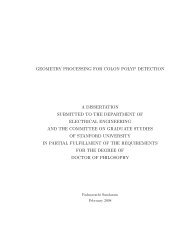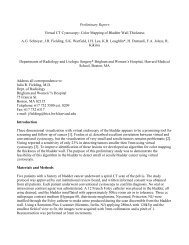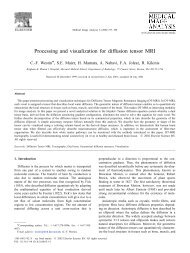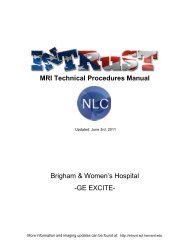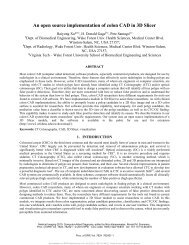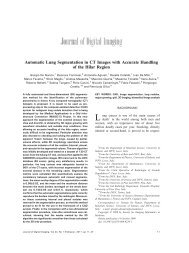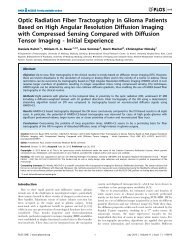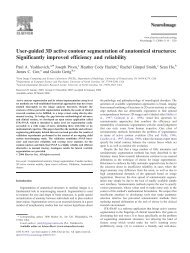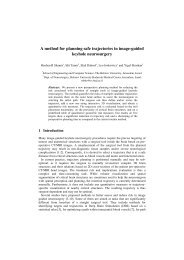Pre - Surgical Planning Laboratory
Pre - Surgical Planning Laboratory
Pre - Surgical Planning Laboratory
- No tags were found...
You also want an ePaper? Increase the reach of your titles
YUMPU automatically turns print PDFs into web optimized ePapers that Google loves.
1.1 Limitations of Conventional <strong>Planning</strong>In tumor ablation, the radiologists try to cover the arbitrarily shaped tumorwith a given number of discrete objects of approximately known shape, representingthe critical ablation temperatures for killing cancerous cells. In cryotherapy,the temperatures within the tumor should nowhere be above, and forthermo-ablation below, this bound. For interstitial tumor ablation, the cooling,respectively heating source is located on the tip of a needle-like probe which ispercutaneously inserted through a catheter into the tumor.The safety and success of a treatment plan depends mainly on the threefollowing points:1. Choosing secure probe trajectories.2. Ablating all the cancerous cells.3. Killing as little of the surrounding healthy tissue as possible.Unfortunately it is very dicult to nd the treatment plan that optimizesthese three central factors when the radiologists have to rely only on 2D-slicesof pre- and intra-operative MR-scans. In such data, the important 3D shapeinformationof the dierent anatomical objects (for example the tumor) andtheir mutual positions is not eciently visualized.1.2 Improving the <strong>Planning</strong> ProcessThe presented tool provides several features to improve the planning process forminimally-invasive percutaneous tumor ablation. Segmented MR scans enablea 3D view of the patient's anatomy and virtual needles visualize eciently theprobe's trajectories (optimize point 1above). We alsosimulate and visualize thefrozen tissue at the tip of the probes. An objective quality measure optimizesand classies the simulated treatment plans according to point 2 and 3 above.Results are presented in the context of liver cryo-therapy ([2]). We showhowour tool can optimize secure probe trajectories and placements while avoidingundertreatment of the tumor.2 MethodsThe main functions of the tool are a 3D visualization of the patient's anatomy, asimulation of the probes and the frozen tissue, and a semi-automated optimizationminimizing an objective quality measure to assess probe placement.2.1 VisualizationTo have avariety of visualization modes at the radiologist's disposal, we addedour planning and simulation tool into an existing software package, called the3D Slicer ([3]). In this way, our planning tool can be used in conjunction with allthe standard functionalities of that program. Let's shortly summarize its mainfeatures:



